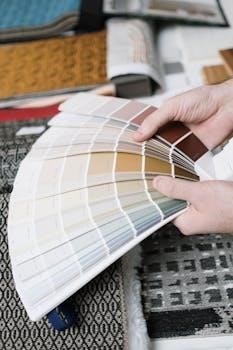Denture gingival shade guides are crucial tools in prosthodontics, aiding in selecting the appropriate color for denture bases․ These guides help replicate natural gum tissues, enhancing the overall aesthetics of the dentures․
Importance of Gingival Shade Matching in Dentures
Accurate gingival shade matching is paramount in denture fabrication, as it directly influences the natural appearance of the prosthesis․ A well-matched shade blends seamlessly with the patient’s existing tissues, enhancing the esthetics and contributing to the patient’s overall satisfaction․ Selecting an appropriate shade ensures the dentures look lifelike and less artificial, improving patient confidence and comfort, especially in complete dentures․

Denture Base Resin Colors and Limitations
Denture base resins come in various pink shades, aiming to mimic natural gingiva․ However, limitations exist as a single shade cannot match the wide variety of natural tissue colors perfectly․
Standard Denture Base Resin Shades
Standard denture base resin shades typically include variations of pink, such as regular pink, dark pink, and veined options․ These shades aim to approximate the natural color of gingival tissue․ Additionally, some resins may come in clear or ethnic-specific shades, offering a wider range of options․ However, these standard shades often have limitations in perfectly matching individual patient’s unique gingival characteristics․ The standard shades are typically used in conjunction with the tooth shade to achieve an overall natural look․
Challenges in Matching Natural Gingiva
Matching natural gingiva with denture base resins presents several challenges․ The wide range of natural gingival shades makes it difficult to achieve a perfect match using only standard resin colors; Factors like ethnicity, age, and individual variations in tissue pigmentation contribute to this difficulty․ Additionally, the translucency and subtle color variations found in natural gums are hard to replicate with standard acrylic resins․ The inability to alter the shade once the denture is completed poses a significant challenge․
Types of Denture Gingival Shade Guides
Denture gingival shade guides vary, including standard guides with basic shades and specialized ones like BruxZir, offering more precise matches․ These tools help dentists select appropriate colors for denture bases․
Standard Shade Guides and Their Use
Standard shade guides for dentures typically feature a range of pink hues, from light to dark, sometimes with veined options․ These guides are utilized by holding them against the patient’s gingival tissue to visually match the shade for the denture base․ They provide a starting point for color selection and aid in achieving a natural look, although they may have limitations in precise shade matching, requiring further individualization techniques․
Specialized Gingival Shade Guides (e․g․, BruxZir)
Specialized gingival shade guides, such as the BruxZir guide, offer shades specifically designed for particular materials, like the BruxZir Full-Arch Implant Prosthesis․ These guides feature tabs that directly correspond to the available shades for the specified prosthesis, ensuring an accurate match; The use of these guides helps facilitate an optimal and predictable esthetic outcome when using advanced prosthetic materials, simplifying shade selection․
The Process of Shade Selection
Selecting the correct gingival shade involves careful consideration of multiple factors․ Accurate shade matching techniques are essential for achieving a natural and aesthetically pleasing result in denture fabrication․
Factors Influencing Shade Selection
Several elements impact gingival shade selection, including the patient’s natural gum color, which varies among ethnicities․ Lighting conditions during shade taking, as well as the surrounding environment, also play a significant role․ Furthermore, the thickness of the denture base material and the presence of any underlying structures can affect the perceived shade․ These factors must be carefully considered to ensure optimal results․
Techniques for Accurate Shade Matching
Accurate shade matching involves using a proper shade guide under controlled lighting conditions․ Comparing the shade tabs against the patient’s natural gingiva at various angles is important․ It is also crucial to view the shades with a neutral background and avoid any surrounding colors that could influence perception․ Digital tools can be also employed to assist in achieving more precise matches, ensuring better aesthetic outcomes․

Individualization and Tinting
Individualizing denture base resins involves using stain kits and non-standardized methods․ These techniques allow for custom shades that mimic natural gingival tissues, improving the overall aesthetics of the dentures․
Methods for Individualizing Denture Base Resins
Individualization of denture base resins often involves the use of specialized stain kits, which allow technicians to create custom shades that closely match a patient’s natural gingiva․ These kits typically include a variety of pigments that can be mixed to achieve the desired color․ Additionally, non-standardized techniques, such as layering different shades of acrylic, are sometimes used to replicate the subtle variations present in real gum tissue, enhancing the denture’s aesthetics․
Use of Stain Kits and Non-Standardized Techniques
Stain kits offer a range of pigments for individualizing denture base resins, allowing for custom color matching of gingival tissues․ These kits help achieve variations in shade and tone․ Non-standardized techniques, like layering different acrylic shades, are also employed․ Such methods help replicate the subtle color nuances found in natural gums, enhancing the overall realism of the dentures, and can be used to achieve a more natural look․

Importance of Patient Satisfaction
Patient satisfaction is significantly influenced by the aesthetic appearance of dentures․ Proper shade selection for the gingival area plays a vital role in achieving a natural and pleasing smile, ensuring patient confidence․
Aesthetic Considerations in Denture Fabrication
Aesthetic considerations are paramount in denture fabrication, extending beyond just tooth color․ The gingival shade, mimicking natural gums, significantly impacts the overall appearance․ Selecting the correct shade ensures harmony with the patient’s facial features and surrounding tissues, contributing to a natural and pleasing smile․ A well-matched gingival shade enhances the lifelike quality of the prosthesis, which is crucial for patient satisfaction and confidence․
Impact of Proper Shade Selection on Patient Satisfaction
Proper gingival shade selection plays a vital role in patient satisfaction with dentures․ A well-matched shade enhances the natural appearance, boosting confidence and comfort․ When the denture base blends seamlessly with the patient’s natural tissues, it creates a more authentic and pleasing smile․ Conversely, a mismatched shade can be noticeable and detract from the overall aesthetic result, leading to dissatisfaction and self-consciousness․
Limitations and Challenges
A significant challenge is the inability to alter the denture base color after fabrication․ Achieving a perfect shade match is difficult, requiring careful selection and technique, which highlights limitations․
Inability to Change Shade After Denture Completion
Once the denture base has been processed, altering its shade is impossible; therefore, the initial shade selection is critical․ There’s no way to lighten or darken the gingiva after completion, making accurate shade matching during the fabrication process paramount․ This constraint necessitates precise planning and patient consultation to avoid irreversible aesthetic discrepancies․ The color cannot be adjusted once completed․
Difficulties in Achieving Perfect Shade Matches
Achieving a perfect shade match for denture gingiva is challenging due to the complex nature of natural tissue․ Variations in thickness, translucency, and individual characteristics make precise replication difficult․ Standard shade guides may not fully capture the wide range of natural gingival colors, leading to potential discrepancies and the need for individualized characterization techniques to better mimic natural tissues and colors․
Communicating Shade Information
Effective communication of shade information to dental laboratories is essential for accurate denture fabrication․ Clear instructions and use of digital tools can improve shade matching success and predictability․
Tips for Effective Shade Communication with Laboratories
To ensure accurate shade matching, provide clear photographs of the patient’s natural gingiva alongside the selected shade tab․ Include detailed descriptions of any unique characteristics, like veining or color variations․ Use standardized terminology and shade guides, specify the light source used during selection, and maintain consistent communication throughout the process․ This minimizes discrepancies and improves final results․
Use of Digital Tools for Shade Matching
Digital tools are increasingly used for shade matching, offering precise color analysis․ Intraoral scanners and spectrophotometers can capture accurate gingival color data․ These tools help minimize human error and provide consistent shade information to the laboratory․ Software applications can also simulate the final denture appearance, aiding in better patient-dentist communication and improving the accuracy of the final prosthesis․

Additional Considerations
Ethnic variations significantly influence gingival shades, requiring careful consideration․ The environment’s lighting also affects shade perception․ These factors highlight the need for personalized shade selection approaches․
Ethnic Variations in Gingival Shades
Gingival shades vary significantly across different ethnicities, with darker shades more common in individuals of African descent compared to those of Caucasian origin․ Asians and other groups may present with unique nuances․ These variations highlight the importance of using shade guides that account for diverse pigmentation, ensuring a natural and aesthetically pleasing outcome for each patient․ Careful consideration of these ethnic differences is crucial for successful denture fabrication․
Influence of Light and Environment on Shade Selection
The surrounding environment and type of light source significantly impact shade perception during denture gingival shade selection․ Natural daylight is often preferred for accurate color matching; however, operatory lighting with controlled color temperature is also acceptable․ Variations in lighting conditions can cause colors to appear different, making it crucial to evaluate shades under consistent and appropriate lighting to ensure precise shade matching․ This helps in avoiding inaccurate shade selection which could impact final aesthetics․
Accurate denture gingival shade selection is vital for patient satisfaction․ Proper techniques, knowledge of available guides, and consideration of various factors, all contribute to achieving natural-looking and aesthetically pleasing results․
Effective gingival shade selection involves understanding the limitations of standard resins and utilizing specialized guides like BruxZir for improved accuracy․ Individualization through staining and tinting is crucial, as is considering ethnic variations․ Communication with dental labs is essential for predictable outcomes․ Patient satisfaction hinges on a natural aesthetic, and being mindful of light and environmental factors during selection is key․
